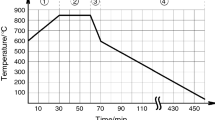Data from physical and chemical studies of gaizes are presented—chemical, phase, and granulometric compositions, degree of crystallinity, and thermal stability in the temperature interval 90 – 1000°C. It is shown that the silica in the studied gaizes exhibits heightened reactivity and the gaizes have low crystallinity and high dispersity, which promotes activation of structural-chemical transformations in gaizes when they are heated.


Similar content being viewed by others
Notes
Here and below, content by weight, %.
References
M. Marinov, L. Lakov, and K. Toncheva, “Technology and equipment for the production of foam glass (review),” Inzhenernye Nauki, 52(1), 78 – 92 (2015).
B. O. Esimov, T. A. Adyrbaeva, and B. E. Zhakipbaev, “Alternative foam material based on gaiza mineral raw material,” Kompleks. Ispolz. Miner. Syrya, No. 2, 92 – 102 (2013).
V. D. Kotlyar, D. I. Bratskii, and A. V. Ustinov, “Material composition and the pre-firing ceramic properties of clay gaizes,” Inzhernyi Vest. Dona: Elektron. Nauch. Zh., No. 4, 2 – 12 (2010); URL: http://www.ivdon.ru/magazine/archive/n4y2010/249.
A. A. Ketov, A. V. Konev, and D. V. Saulin, “Trends in the development of foam glass technology, Stroit. Mater., No. 9, 2 – 5 (2007).
F. Shill, Foam Glass [in Russian], Literatura po Stroitelstvu, Moscow (1965), pp. 9 – 84.
B. K. Demidovich, Production and Use of Foam Glass [in Russian], Nauka i tekhnika, Minsk (1972), pp. 5 – 168.
N. I. Zabulina, E. V. Perfilyeva, and A. V. Shurlo, “Influence of raw materials on the properties of foam glass,” Construction Materials and Ware: Coll. Works [in Russian], Magnitogorsk Gos. Tekhnologich. Universitet, Magnitogorsk (2013), pp. 45 – 46.
F. E. Zhernovoy, N. F. Zhernovaya, and M. V. Shukaeva, “Effectiveness of gaize-containing causticized batches for glass containers,” Steklo Keram., 72(3), 83 – 85 (2015); F. E. Zhernovoy, N. F. Zhernovaya, and M. V. Shukaeva, “Effectiveness of gaize-containing causticized batches for glass containers,” Glass Ceram., 72(3 – 4), 83 – 85 (2015).
A. A. Zhimalov, L. N. Bondareva, Yu. G. Igitkhanyan, and Yu. G. Ivashchenko, “Use of amorphous siliceous rocks — gaizes to obtain foam glass with low foaming temperature,” Steklo Keram., No. 1, 14 – 15 (2017); A. A. Zhimalov, L. N. Bondareva, Yu. G. Igitkhanyan, and Yu. G. Ivashchenko, “Use of amorphous siliceous rocks — gaizes to obtain foam glass with low foaming temperature,” Glass Ceram., 74(1 – 2), 13 – 15 (2017).
I. I. Kitaigorodskii (ed.), Glass Technology [in Russian], Stroiizdat, Moscow (1961).
Author information
Authors and Affiliations
Corresponding author
Additional information
Translated from Steklo i Keramika, No. 10, pp. 15 – 18, October, 2018.
Rights and permissions
About this article
Cite this article
Zhimalov, A.A., Nikishonkova, O.A., Spiridonov, Y.A. et al. Physical-Chemical Studies of Gaizes as Alternative Raw Materials for the Production of Foam Glass and Foam Materials. Glass Ceram 75, 387–390 (2019). https://doi.org/10.1007/s10717-019-00091-9
Published:
Issue Date:
DOI: https://doi.org/10.1007/s10717-019-00091-9




